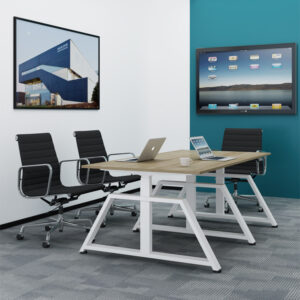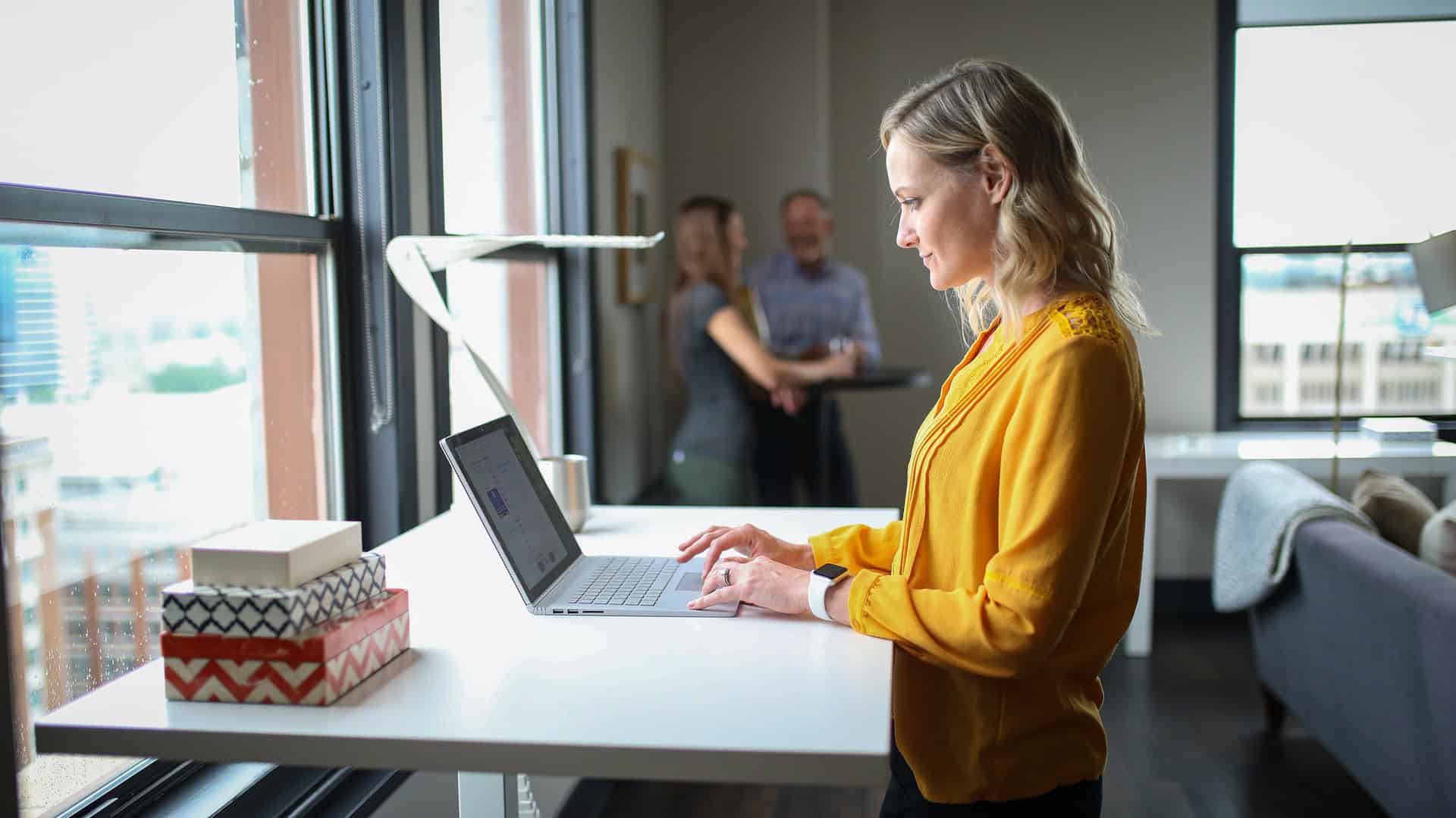Health Benefits
The sedentary office lifestyle has become a global epidemic, with many employees spending the majority of their day parked in front of a computer. This sedentary behavior has been linked to a myriad of health issues, including obesity, heart disease, diabetes, and even certain types of cancer. Standing desks have emerged as a viable solution to counteract the negative effects of prolonged sitting. In this section, we will explore the health benefits of standing desks and how they can improve the well-being of individuals in the workplace.
 Reducing Sedentary Time
Reducing Sedentary Time
Prolonged sitting has been dubbed “the new smoking” due to its detrimental health effects. Sitting for extended periods can lead to a host of health problems, including increased risk of heart disease, diabetes, and obesity. Standing desks offer a simple yet effective solution to break up long periods of sitting. By providing an alternative to sitting, standing desks encourage users to be more active throughout the day, which can lead to significant health improvements.
Improving Posture
Sitting all day can lead to poor posture, which can cause chronic back, neck, and shoulder pain. Standing desks promote a more natural upright posture, which can help alleviate these issues. When using a standing desk, users are less likely to slouch or hunch over their work, which can lead to a stronger and straighter spine. This improved posture not only reduces pain but also contributes to a more professional and confident appearance.
Promoting Blood Circulation
Sitting for long periods can slow down blood circulation, which can lead to blood clots and other cardiovascular issues. Standing up and moving around helps to improve blood flow throughout the body. Standing desks provide the opportunity for individuals to change positions and stimulate blood circulation, reducing the risk of cardiovascular diseases and improving overall health.
Relieving Back and Neck Pain
One of the most common complaints among office workers is back and neck pain caused by long hours of sitting. Sitting places strain on the spine and can lead to muscle imbalances and tension. Standing desks allow for a more even distribution of body weight and can help to reduce the pressure on the spine. Many users report a decrease in back and neck pain after transitioning to a standing desk, as it encourages regular movement and changes in posture throughout the day.
Standing desks offer a range of health benefits that can significantly improve the quality of life for office workers. By reducing sedentary time, improving posture, promoting blood circulation, and relieving back and neck pain, standing desks are a valuable addition to any workspace. As we delve further into the impact of standing desks, it’s clear that their influence extends beyond physical health and into the realm of work efficiency and office culture.
Work Efficiency
In addition to the health benefits, standing desks have been touted as a productivity booster in the workplace. As the modern office evolves to accommodate the well-being of its workers, the concept of active workstations is gaining traction. Let’s explore how standing desks can enhance focus, invigorate creativity, and break the monotony of a traditional sedentary workday.
 Enhancing Focus and Concentration
Enhancing Focus and Concentration
Research has shown that standing can increase blood flow to the brain, which may contribute to heightened alertness and concentration. The subtle increase in physical activity associated with standing desks can also help to combat the afternoon slump that often plagues sedentary workers. Employees who use standing desks often report feeling more awake and engaged throughout the day, which can lead to a more productive work environment.
Increasing Energy and Creativity
Standing has been linked to an increase in energy levels, which can have a positive impact on creativity and out-of-the-box thinking. When we stand, our bodies are more alert and ready for action, which can translate to a more dynamic and innovative mindset. This energetic state can be particularly beneficial for tasks that require creative thinking or problem-solving, giving employees the edge they need to excel in their roles.
Breaking the Monotony of Sitting
Sitting for long periods can lead to mental fatigue and a sense of stagnation. The ability to switch between sitting and standing throughout the day can help to break up the monotony and keep workers feeling fresh and motivated. Standing desks provide a simple way to introduce variety into the workday, which can help to prevent burnout and maintain a consistent level of productivity.

Case Studies and User Experiences
Case Study: A study conducted by the University of Leicester found that call center employees who used standing desks took 46% fewer sick days than their seated counterparts. This suggests that standing desks not only improve health but also contribute to a more reliable and present workforce.
User Experience: Software developer, Mark T., reported a significant increase in his productivity after switching to a standing desk. He noted, “I used to struggle to stay focused in the afternoon, but now that I stand, I find it easier to concentrate and I’m getting more done.”
The Impact on the Workplace
The introduction of standing desks in the workplace has the potential to create a more dynamic and engaged workforce. By offering employees the option to stand, companies are not only investing in the health of their staff but also in their ability to work efficiently and effectively. As more companies recognize the benefits of standing desks, we’ll likely see a shift towards more active and healthy office environments.
Standing desks are more than just a health fad; they offer tangible benefits to work efficiency and employee well-being. By enhancing focus and concentration, increasing energy and creativity, and breaking the monotony of sitting, standing desks are proving to be a valuable asset in the modern workplace. As we move into the next section, we’ll explore how standing desks are influencing office culture and design, further cementing their role in the future of work.
Office Culture and Design
The integration of standing desks into the workplace isn’t just a trend; it’s a shift in office culture and design that reflects a deeper understanding of employee well-being and productivity. As organizations increasingly recognize the importance of a healthy work-life balance, the office environment is evolving to support active and engaged employees. Let’s delve into how standing desks are fostering a new office culture and influencing design trends.
 Fostering an Active Office Culture
Fostering an Active Office Culture
The traditional image of an office filled with rows of seated workers pecking away at their keyboards is rapidly changing. Standing desks are at the forefront of this shift, encouraging a more active office culture. By providing employees with the option to stand, companies are promoting a healthier lifestyle that can bleed into other areas, such as exercise and nutrition. This cultural change is not only about the physical benefits; it’s also about creating an environment that supports overall well-being and encourages employees to take an active role in their health.
The Importance of Ergonomics
Ergonomics, the science of designing the office environment for optimal comfort and efficiency, is a critical component of modern office design. Standing desks are an ergonomic solution that allows for adjustable workstations, catering to the diverse needs of employees. The ability to customize the height and angle of a desk supports proper posture and reduces the risk of musculoskeletal disorders. This focus on ergonomics not only benefits individual employees but also reflects a company’s commitment to the long-term health of its workforce.
Aesthetics and Flexibility
In the modern office, form and function go hand in hand. Standing desks are not only practical but also aesthetically pleasing, with designs that complement a variety of office environments. Their flexibility in terms of height adjustment and space-saving designs make them an attractive addition to any office. The clean, streamlined look of many standing desks can contribute to a more professional and contemporary office aesthetic, which can have a positive impact on both employee morale and client impressions.
Real-World Applications and Success Stories
Google and Facebook: These tech giants have embraced the standing desk trend, offering them as an option to employees. The result has been a more dynamic work environment that supports creativity and innovation.
Design-Forward Companies: Firms like IDEO and WeWork have incorporated standing desks into their office designs, creating spaces that inspire movement and collaboration. The standing desk has become a symbol of a forward-thinking and employee-centric workplace.
The Future of Office Design
As standing desks become more prevalent, office design is likely to continue evolving to support active work styles. We may see more offices incorporating biophilic design elements that connect workers with nature, along with灵动的空间布局 that encourages movement throughout the day. The standing desk is just the beginning of a broader trend toward offices that promote health, well-being, and productivity.
Standing desks are transforming office culture and design by fostering activity, prioritizing ergonomics, and enhancing aesthetics. They are more than just a piece of furniture; they’re a reflection of a company’s values and its commitment to the well-being of its employees. As we look ahead to the next section, we’ll examine the economic and environmental impacts of standing desks, further understanding their role in the sustainable office of the future.
Economic and Environmental Impact
 The introduction of standing desks in the workplace is not just a trend; it represents a significant shift in how we view work-life balance and sustainability. As companies increasingly prioritize employee health and environmental stewardship, the economic and environmental impacts of office design choices like standing desks become more pronounced. Let’s explore how standing desks are influencing the bottom line and the planet.
The introduction of standing desks in the workplace is not just a trend; it represents a significant shift in how we view work-life balance and sustainability. As companies increasingly prioritize employee health and environmental stewardship, the economic and environmental impacts of office design choices like standing desks become more pronounced. Let’s explore how standing desks are influencing the bottom line and the planet.
Cost-Benefit Analysis
While the upfront cost of standing desks can be higher than traditional sitting desks, the long-term savings in health care costs and increased productivity can offset the initial expense. Studies have shown that standing desks can lead to a decrease in sick days and an improvement in employee health, which translates to cost savings for employers. Additionally, the potential increase in productivity can lead to greater output and revenue.
Sustainability
Standing desks can also be designed with sustainability in mind. Materials such as reclaimed wood, recycled metal, and eco-friendly finishes are increasingly used in the manufacturing of these desks. Furthermore, the reduced need for extensive medical intervention due to improved health can contribute to a smaller environmental footprint in terms of healthcare waste.
Office Culture Shift
The rise of standing desks reflects a broader shift in office culture towards active and healthy work environments
. This shift not only benefits individual employees but also aligns with the growing consumer demand for corporate social responsibility and sustainability. Companies that prioritize employee well-being and environmental sustainability can enhance their brand image and attract a new generation of workers who value these principles.
Market Trends
The market for standing desks is growing, indicating a strong consumer demand for healthier office solutions. This growth is expected to continue as more companies recognize the benefits of standing desks and as technology advances to make these desks more affordable and accessible.
 Long-Term Health Impacts
Long-Term Health Impacts
Investing in standing desks can lead to long-term health benefits for employees, reducing the risk of chronic diseases associated with sedentary behavior. This not only improves the quality of life for workers but also decreases the burden on healthcare systems, which has significant economic and societal implications.
Standing desks are more than just a workplace accessory; they are a reflection of a company’s commitment to employee health and environmental sustainability. As the market for these desks continues to grow, we can expect to see a ripple effect on office culture, healthcare costs, and the overall sustainability of our work environments.
Conclusion
Standing desks present various challenges, from physical discomfort to cost considerations. However, with the right strategies and solutions, these challenges can be overcome, leading to a healthier and more productive workplace. As more companies recognize the benefits of standing desks and more employees demand healthier work environments, we’ll likely see even more innovation in this area, making standing desks more accessible and effective for all.
Companies can create a healthier, more engaged, and productive workforce by addressing the challenges associated with standing desks and implementing thoughtful solutions. As we look to the future, the standing desk will become an integral part of the modern office, promoting wellness and efficiency in equal measure.



